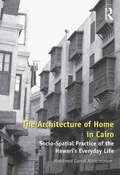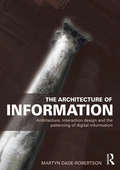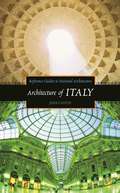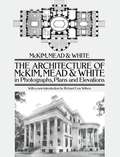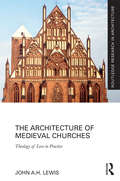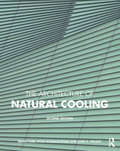- Table View
- List View
The Architecture of Home in Cairo: Socio-Spatial Practice of the Hawari's Everyday Life
by Mohamed Gamal AbdelmonemThe hawari of Cairo - narrow non-straight alleyways - are the basic urban units that have formed the medieval city since its foundation back in 969 AD. Until early in the C20th, they made up the primary urban divisions of the city and were residential in nature. Contemporary hawari, by contrast, are increasingly dominated by commercial and industrial activity. This medieval urban maze of extremely short, broken, zigzag streets and dead ends are defensible territories, powerful institutions, and important social systems. While the hawari have been studied as an exemplar for urban structure of medieval Islamic urbanism, and as individual building typologies, this book is the first to examine in detail the socio-spatial practice of the architecture of home in the city. It investigates how people live, communicate and relate to each other within their houses or shared spaces of the alleys, and in doing so, to uncover several new socio-spatial dimensions and meanings in this architectural form. In an attempt to re-establish the link between architecture past and present, and to understand the changing social needs of communities, this book uncovers the notion of home as central to understand architecture in such a city with long history as Cairo. It firstly describes the historical development of the domestic spaces (indoor and outdoor), and provides an inclusive analysis of spaces of everyday activities in the hawari of old Cairo. It then broadens its analysis to other parts of the city, highlighting different customs and representations of home in the city at large. Cairo, in the context of this book, is represented as the most sophisticated urban centre in the Middle East with different and sometimes contrasting approaches to the architecture of home, as a practice and spatial system. In order to analyse the complexity and interconnectedness of the components and elements of the hawari as a 'collective home', it layers its narratives of architectural and social developments as a domestic environment over the past two hundred years, and in doing so, explores the in-depth social meaning and performance of spaces, both private and public.
The Architecture of Home in Cairo: Socio-Spatial Practice of the Hawari's Everyday Life
by Mohamed Gamal AbdelmonemThe hawari of Cairo - narrow non-straight alleyways - are the basic urban units that have formed the medieval city since its foundation back in 969 AD. Until early in the C20th, they made up the primary urban divisions of the city and were residential in nature. Contemporary hawari, by contrast, are increasingly dominated by commercial and industrial activity. This medieval urban maze of extremely short, broken, zigzag streets and dead ends are defensible territories, powerful institutions, and important social systems. While the hawari have been studied as an exemplar for urban structure of medieval Islamic urbanism, and as individual building typologies, this book is the first to examine in detail the socio-spatial practice of the architecture of home in the city. It investigates how people live, communicate and relate to each other within their houses or shared spaces of the alleys, and in doing so, to uncover several new socio-spatial dimensions and meanings in this architectural form. In an attempt to re-establish the link between architecture past and present, and to understand the changing social needs of communities, this book uncovers the notion of home as central to understand architecture in such a city with long history as Cairo. It firstly describes the historical development of the domestic spaces (indoor and outdoor), and provides an inclusive analysis of spaces of everyday activities in the hawari of old Cairo. It then broadens its analysis to other parts of the city, highlighting different customs and representations of home in the city at large. Cairo, in the context of this book, is represented as the most sophisticated urban centre in the Middle East with different and sometimes contrasting approaches to the architecture of home, as a practice and spatial system. In order to analyse the complexity and interconnectedness of the components and elements of the hawari as a 'collective home', it layers its narratives of architectural and social developments as a domestic environment over the past two hundred years, and in doing so, explores the in-depth social meaning and performance of spaces, both private and public.
The Architecture of Industry: Changing Paradigms in Industrial Building and Planning (Ashgate Studies in Architecture)
by Mathew AitchisonFrom the Rust Belt to Silicon Valley, the intersection between architecture and industry has provided a rich and evolving source for historians of architecture. In a historical context, industrial architecture evokes the smoking factories of the nineteenth century or Fordist production complexes of the twentieth century. This book documents the changing nature of industrial building and planning from the end of the nineteenth century to the beginning of the twenty-first century. Drawing on research from the United States, Europe and Australia, this collection of essays highlights key moments in industrial architecture and planning representative of the wider paradigms in the field. Areas of analysis include industrial production, factories, hydroelectricity, aerospace, logistics, finance, scientific research and mining. The selected case studies serve to highlight architectural and planning innovations in industry and their contributions to wider cultural and societal currents. This richly illustrated collection will be of interest for a wide range of built environment studies, incorporating findings from both historical and theoretical scholarship and design research.
The Architecture of Industry: Changing Paradigms in Industrial Building and Planning (Ashgate Studies in Architecture)
by Mathew AitchisonFrom the Rust Belt to Silicon Valley, the intersection between architecture and industry has provided a rich and evolving source for historians of architecture. In a historical context, industrial architecture evokes the smoking factories of the nineteenth century or Fordist production complexes of the twentieth century. This book documents the changing nature of industrial building and planning from the end of the nineteenth century to the beginning of the twenty-first century. Drawing on research from the United States, Europe and Australia, this collection of essays highlights key moments in industrial architecture and planning representative of the wider paradigms in the field. Areas of analysis include industrial production, factories, hydroelectricity, aerospace, logistics, finance, scientific research and mining. The selected case studies serve to highlight architectural and planning innovations in industry and their contributions to wider cultural and societal currents. This richly illustrated collection will be of interest for a wide range of built environment studies, incorporating findings from both historical and theoretical scholarship and design research.
An Architecture of Ineloquence: A Study in Modern Architecture and Religion (Ashgate Studies in Architecture)
by J.K. BirkstedSet on a hillside near Cluny, in a region associated with religious institutions and sacred architecture (including Le Corbusier's La Tourette), Le Carmel de la Paix, designed by José Luis Sert, remains tranquilly unvisited and quietly erased from architectural history. Why? This unusual convent falls outside the standard categories of Sert's architecture and has been overlooked in most publications about his work. As J.K. Birksted explains, the design and construction process for this building proved nightmarish, resulting in a building which, at first sight, appears to be 'ineloquent'. This first detailed examination of this building shows how the convent and the story of its creation offer valuable and important new insights into Sert, his architecture and his life. However, the study also opens up discussions on wider subjects such as the relationships between modernist architecture and ecclesiastical architecture. The design and construction of the Carmel de la Paix (1968-1972) followed the Second Ecumenical Council of the Vatican (1962-1965), which introduced fundamental changes and proposals for renewing the relationship between the Church and the changing modern world and the convent provides an interesting illustration of this period. In addition, it offers insights into the fascinating world of the Carmelite order and its specific liturgical requirements, and, reflecting on the nuns' active involvement in the design and construction process, it also explores wider issues of women in architecture.
An Architecture of Ineloquence: A Study in Modern Architecture and Religion (Ashgate Studies in Architecture)
by J.K. BirkstedSet on a hillside near Cluny, in a region associated with religious institutions and sacred architecture (including Le Corbusier's La Tourette), Le Carmel de la Paix, designed by José Luis Sert, remains tranquilly unvisited and quietly erased from architectural history. Why? This unusual convent falls outside the standard categories of Sert's architecture and has been overlooked in most publications about his work. As J.K. Birksted explains, the design and construction process for this building proved nightmarish, resulting in a building which, at first sight, appears to be 'ineloquent'. This first detailed examination of this building shows how the convent and the story of its creation offer valuable and important new insights into Sert, his architecture and his life. However, the study also opens up discussions on wider subjects such as the relationships between modernist architecture and ecclesiastical architecture. The design and construction of the Carmel de la Paix (1968-1972) followed the Second Ecumenical Council of the Vatican (1962-1965), which introduced fundamental changes and proposals for renewing the relationship between the Church and the changing modern world and the convent provides an interesting illustration of this period. In addition, it offers insights into the fascinating world of the Carmelite order and its specific liturgical requirements, and, reflecting on the nuns' active involvement in the design and construction process, it also explores wider issues of women in architecture.
The Architecture of Information: Architecture, Interaction Design and the Patterning of Digital Information
by Martyn Dade-RobertsonThis book looks at relationships between the organization of physical objects in space and the organization of ideas. Historical, philosophical, psychological and architectural knowledge are united to develop an understanding of the relationship between information and its representation. Despite its potential to break the mould, digital information has relied on metaphors from a pre-digital era. In particular, architectural ideas have pervaded discussions of digital information, from the urbanization of cyberspace in science fiction, through to the adoption of spatial visualizations in the design of graphical user interfaces. This book tackles: the historical importance of physical places to the organization and expression of knowledge the limitations of using the physical organization of objects as the basis for systems of categorization and taxonomy the emergence of digital technologies and the twentieth century new conceptual understandings of knowledge and its organization the concept of disconnecting storage of information objects from their presentation and retrieval ideas surrounding ‘semantic space’ the realities of the types of user interface which now dominate modern computing.
The Architecture of Information: Architecture, Interaction Design and the Patterning of Digital Information
by Martyn Dade-RobertsonThis book looks at relationships between the organization of physical objects in space and the organization of ideas. Historical, philosophical, psychological and architectural knowledge are united to develop an understanding of the relationship between information and its representation. Despite its potential to break the mould, digital information has relied on metaphors from a pre-digital era. In particular, architectural ideas have pervaded discussions of digital information, from the urbanization of cyberspace in science fiction, through to the adoption of spatial visualizations in the design of graphical user interfaces. This book tackles: the historical importance of physical places to the organization and expression of knowledge the limitations of using the physical organization of objects as the basis for systems of categorization and taxonomy the emergence of digital technologies and the twentieth century new conceptual understandings of knowledge and its organization the concept of disconnecting storage of information objects from their presentation and retrieval ideas surrounding ‘semantic space’ the realities of the types of user interface which now dominate modern computing.
Architecture of Italy (Reference Guides to National Architecture)
by Jean CastexCovering all regions of Italy—from Turin's Palace of Labor in northern Italy to the Monreale Cathedral and Cloister in Sicily—and all periods of Italian architecture—from the first-century Colosseum in Rome to the Casa Rustica apartments built in Milan in the 1930s—this volume examines over 70 of Italy's most important architectural landmarks. Writing in an authoritative yet engaging style, Jean Castex, professor of architectural history at the Versailles School of Architecture, describes the features, functions, and historical importance of each structure. Besides idetifying location, style, architects, and periods of initial construction and major renovations, the cross-referenced and illustrated entries also highlight architectural and historical terms explained in the Glossay and conclude with a useful listing of further information resources. The volume also offers ready-reference lists of entries by location, architectural style, and time period, as well as a general bibliography, a detailed subject index, and a comprehensive introductory overview of Italian architecture.Entries cover major architectural structures as well as smaller sites, including everything from the well-known dome of St. Peter's at the Vatican to the Fiat Lingotto Plant in Turin. Ideal for college and high school students, as well as for interested general readers, this comprehensive look at the architecture of Italy is an indispensable addition to every architectural reference collection.
The Architecture of James Stirling and His Partners James Gowan and Michael Wilford: A Study of Architectural Creativity in the Twentieth Century
by Geoffrey H. BakerSir James Stirling was arguably the greatest British architect of the twentieth century. This book provides the most comprehensive critical survey of Stirling's work to date, charting the development of his ideas from his formative years, through his partnership with James Gowan, on to his period in practice as sole partner; and finally, his partnership with Michael Wilford. Using archival material, extensive interviews with his partners and others who worked for him, together with analytical examination of key buildings, this detailed critical examination explains his philosophy, working method and design strategy. In doing so, it sheds new light on the atelier structure of his office and who did what on his major buildings. Geoffrey Baker is the first to analyse in depth the articulation systems used in major projects undertaken by Stirling. He confirms that the Staatsgalerie complex at Stuttgart does not demonstrate Stirling's interest in post modernism but rather an enhanced sensitivity towards context informed by his growing allegiance to the classical canon. Baker explains how this important development in his work, powerfully influenced by Karl Friedrich Schinkel, is consummated in perhaps the finest of Stirling's uncompleted works, the extension to London's National Gallery. In a discussion of his mature works, Baker explains how Stirling's work can be understood in terms of several interconnected ideas. These include surrealism, historicism, myth and metaphor, inconsistency and ambiguity, bi-lateral symmetry, the garden, rusticity and arcadia, and the archetype, seen as the repository of the collective architectural memory. As well as discussing his interests and those who influenced Stirling, the book compares his oeuvre with that of the pioneers of modern architecture, Mies van der Rohe, Frank Lloyd Wright, Alvar Aalto and Le Corbusier. This book charts a remarkable career, and offers invaluable insights not only into the masterly, timeless architecture, but also into the man himself: charismatic, irreverent, courageous, serious; sometimes rude, often stubborn, belligerent, yet gentle. He was endlessly inventive and deeply dedicated to his art, producing buildings that reflect all of the above, buildings that are magnificent and ultimately humane.
The Architecture of James Stirling and His Partners James Gowan and Michael Wilford: A Study of Architectural Creativity in the Twentieth Century
by Geoffrey H. BakerSir James Stirling was arguably the greatest British architect of the twentieth century. This book provides the most comprehensive critical survey of Stirling's work to date, charting the development of his ideas from his formative years, through his partnership with James Gowan, on to his period in practice as sole partner; and finally, his partnership with Michael Wilford. Using archival material, extensive interviews with his partners and others who worked for him, together with analytical examination of key buildings, this detailed critical examination explains his philosophy, working method and design strategy. In doing so, it sheds new light on the atelier structure of his office and who did what on his major buildings. Geoffrey Baker is the first to analyse in depth the articulation systems used in major projects undertaken by Stirling. He confirms that the Staatsgalerie complex at Stuttgart does not demonstrate Stirling's interest in post modernism but rather an enhanced sensitivity towards context informed by his growing allegiance to the classical canon. Baker explains how this important development in his work, powerfully influenced by Karl Friedrich Schinkel, is consummated in perhaps the finest of Stirling's uncompleted works, the extension to London's National Gallery. In a discussion of his mature works, Baker explains how Stirling's work can be understood in terms of several interconnected ideas. These include surrealism, historicism, myth and metaphor, inconsistency and ambiguity, bi-lateral symmetry, the garden, rusticity and arcadia, and the archetype, seen as the repository of the collective architectural memory. As well as discussing his interests and those who influenced Stirling, the book compares his oeuvre with that of the pioneers of modern architecture, Mies van der Rohe, Frank Lloyd Wright, Alvar Aalto and Le Corbusier. This book charts a remarkable career, and offers invaluable insights not only into the masterly, timeless architecture, but also into the man himself: charismatic, irreverent, courageous, serious; sometimes rude, often stubborn, belligerent, yet gentle. He was endlessly inventive and deeply dedicated to his art, producing buildings that reflect all of the above, buildings that are magnificent and ultimately humane.
The Architecture of Late Assyrian Royal Palaces
by David KertaiThe Late Assyrian Empire (c. 900 - 612 BCE) was the first state to rule over the major centres of the Middle East, and the Late Assyrian court inhabited some of the most monumental palaces of its time. The Architecture of Late Assyrian Royal Palaces is the first volume to provide an in-depth analysis of Late Assyrian palatial architecture, offering a general introduction to all key royal palaces in the major centres of the empire: Assur, Kalḫu, Dur-Sharruken, and Nineveh. Where previous research has often focused on the duality between public and private realms, this volume redefines the cultural principles governing these palaces and proposes a new historical framework, analysing the spatial organization of the palace community which placed the king front and centre. It brings together the architecture of such palaces as currently understood within the broader framework of textual and art-historical sources, and argues that architectural changes were guided by a need to accommodate ever larger groups as the empire grew in size.
The Architecture of Light: Recent Approaches to Designing with Natural Light
by Mary Ann SteaneReviewing the use of natural light by architects in the era of electricity, this book aims to show that natural light not only remains a potential source of order in architecture, but that natural lighting strategies impose a usefully creative discipline on design. Considering an approach to environmental context that sees light as a critical aspect of place, this book explores current attitudes to natural light by offering a series of in-depth studies of recent projects and the particular lighting issues they have addressed. It gives a more nuanced appraisal of these lighting strategies by setting them within their broader topographic, climatic and cultural contexts.
The Architecture of Light: Recent Approaches to Designing with Natural Light
by Mary Ann SteaneReviewing the use of natural light by architects in the era of electricity, this book aims to show that natural light not only remains a potential source of order in architecture, but that natural lighting strategies impose a usefully creative discipline on design. Considering an approach to environmental context that sees light as a critical aspect of place, this book explores current attitudes to natural light by offering a series of in-depth studies of recent projects and the particular lighting issues they have addressed. It gives a more nuanced appraisal of these lighting strategies by setting them within their broader topographic, climatic and cultural contexts.
The Architecture of Luxury (Ashgate Studies in Architecture)
by Annette CondelloOver the past century, luxury has been increasingly celebrated in the sense that it is no longer a privilege (or attitude) of the European elite or America’s leisure class. It has become more ubiquitous and now, practically everyone can experience luxury, even luxury in architecture. Focusing on various contexts within Western Europe, Latin America and the United States, this book traces the myths and application of luxury within architecture, interiors and designed landscapes. Spanning from antiquity to the modern era, it sets out six historical categories of luxury - Sybaritic, Lucullan, architectural excess, rustic, neoEuropean and modern - and relates these to the built and unbuilt environment, taking different cultural contexts and historical periods into consideration. It studies some of the ethical questions raised by the nature of luxury in architecture and discusses whether architectural luxury is an unqualified benefit or something which should only be present within strict limits. The author argues how the ideas of permissible and impermissible luxury have informed architecture and how these notions of ethical approval have changed from one context to another. Providing voluptuous settings for the nobles and the leisure class, luxury took the form of not only grand palaces, but also follies, country and suburban houses, private or public entertainment venues and ornate skyscrapers with fast lifts. The Architecture of Luxury proposes that in Western societies the growth of the leisure classes and their desire for various settings for pleasure resulted in a constantly increasing level of ’luxury’ sought within everyday architecture.
The Architecture of Luxury (Ashgate Studies in Architecture)
by Annette CondelloOver the past century, luxury has been increasingly celebrated in the sense that it is no longer a privilege (or attitude) of the European elite or America’s leisure class. It has become more ubiquitous and now, practically everyone can experience luxury, even luxury in architecture. Focusing on various contexts within Western Europe, Latin America and the United States, this book traces the myths and application of luxury within architecture, interiors and designed landscapes. Spanning from antiquity to the modern era, it sets out six historical categories of luxury - Sybaritic, Lucullan, architectural excess, rustic, neoEuropean and modern - and relates these to the built and unbuilt environment, taking different cultural contexts and historical periods into consideration. It studies some of the ethical questions raised by the nature of luxury in architecture and discusses whether architectural luxury is an unqualified benefit or something which should only be present within strict limits. The author argues how the ideas of permissible and impermissible luxury have informed architecture and how these notions of ethical approval have changed from one context to another. Providing voluptuous settings for the nobles and the leisure class, luxury took the form of not only grand palaces, but also follies, country and suburban houses, private or public entertainment venues and ornate skyscrapers with fast lifts. The Architecture of Luxury proposes that in Western societies the growth of the leisure classes and their desire for various settings for pleasure resulted in a constantly increasing level of ’luxury’ sought within everyday architecture.
The Architecture of McKim, Mead & White in Photographs, Plans and Elevations
by Mead White McKimThe roster of McKim, Mead & White's clients reads like a who's-who of American business, professional, cultural, and social enterprise in the late nineteenth and early twentieth centuries. Many of the buildings designed by this distinguished New York firm still stand today — libraries, museums, churches, train stations, banks, office buildings, private clubs, and residences — an imposing testament to the splendor and durability of its achievement.This magnificent pictorial history is one of the most important documents in the history of American architecture. In 435 superb photographs and over 500 line illustrations, including both floor plans and elevations, it surveys over 160 structures designed by the architects of McKim, Mead & White. Originally published in four massive volumes and now available in an unabridged one-volume paperback edition, this handsome book depicts such famous New York City landmarks (present and former) as Columbia University's Low Library, the Pierpont Morgan Library, the Municipal Building, the second Madison Square Garden, and the original Pennsylvania Station.Other major landmarks include private and public buildings and other structures in Boston, Cambridge, Newport, Providence, Princeton, Philadelphia, Washington, D.C., Chicago, and Montreal. For architects and architectural historians, this book will be a valuable source for its comprehensive views of an unrivaled achievement in American architecture. Social historians and students of Americana will find it revealing for its reflection of the ideas and culture of the times. A new Introduction by Richard Guy Wilson perceptively appraises the McKim, Mead & White legacy for today's readers.
The Architecture of Medieval Churches: Theology of Love in Practice (Routledge Research in Architecture)
by John A.H. LewisThe Architecture of Medieval Churches investigates the impact of affective theology on architecture and artefacts, focusing on the Middle Ages as a period of high achievement of this synthesis. It explores aspects of medieval church and cathedral architecture in relation to the contemporary metaphysics and theology, which articulated an integrated theocentric culture, architecture, and art. Three modes of attention: comprehension, instruction, and contemplation, informed the builders’ intuition and intention. The book’s central premise reasons that love for God was the critical force in the creation of vernacular church architecture, using a selection of medieval writings to provide a unique critique of the genius of architecture and art during this period. An interdisciplinary study between architecture, theology, and philosophy, it will appeal to academics and researchers in these fields.
The Architecture of Medieval Churches: Theology of Love in Practice (Routledge Research in Architecture)
by John A.H. LewisThe Architecture of Medieval Churches investigates the impact of affective theology on architecture and artefacts, focusing on the Middle Ages as a period of high achievement of this synthesis. It explores aspects of medieval church and cathedral architecture in relation to the contemporary metaphysics and theology, which articulated an integrated theocentric culture, architecture, and art. Three modes of attention: comprehension, instruction, and contemplation, informed the builders’ intuition and intention. The book’s central premise reasons that love for God was the critical force in the creation of vernacular church architecture, using a selection of medieval writings to provide a unique critique of the genius of architecture and art during this period. An interdisciplinary study between architecture, theology, and philosophy, it will appeal to academics and researchers in these fields.
The Architecture of Michelangelo (Pelican Bks.)
by James S. AckermanIn this widely acclaimed work, James Ackerman considers in detail the buildings designed by Michelangelo in Florence and Rome—including the Medici Chapel, the Farnese Palace, the Basilica of St. Peter, and the Capitoline Hill. He then turns to an examination of the artist's architectural drawings, theory, and practice. As Ackerman points out, Michelangelo worked on many projects started or completed by other architects. Consequently this study provides insights into the achievements of the whole profession during the sixteenth century. The text is supplemented with 140 black-and-white illustrations and is followed by a scholarly catalog of Michelangelo's buildings that discusses chronology, authorship, and condition. For this second edition, Ackerman has made extensive revisions in the catalog to encompass new material that has been published on the subject since 1970.
Architecture of Modern China: A Historical Critique
by Jianfei ZhuA collection of essays on architecture of modern China, arranged chronologically covering a period from 1729 to 2008, focusing mainly on the twentieth century. The distinctive feature of this book is a blending of ‘critical’ and ‘historical’ research, taking a long-range perspective transcending the current scene and the Maoist period. This is a short, elegant book that condenses the wide subject matter into key topics.
Architecture of Modern China: A Historical Critique
by Jianfei ZhuA collection of essays on architecture of modern China, arranged chronologically covering a period from 1729 to 2008, focusing mainly on the twentieth century. The distinctive feature of this book is a blending of ‘critical’ and ‘historical’ research, taking a long-range perspective transcending the current scene and the Maoist period. This is a short, elegant book that condenses the wide subject matter into key topics.
The Architecture of Natural Cooling
by Brian Ford Rosa Schiano-Phan Juan A. VallejoOverheating in buildings is commonplace. This book describes how we can keep cool without conventional air-conditioning: improving comfort and productivity while reducing energy costs and carbon emissions. It provides architects, engineers and policy makers with a ‘how-to’ guide to the application of natural cooling in new and existing buildings. It demonstrates, through reference to numerous examples, that natural cooling is viable in most climates around the world. This completely revised and expanded second edition includes: An overview of natural cooling past and present. Guidance on the principles and strategies that can be adopted. A review of the applicability of different strategies. Explanation of simplified tools for performance assessment. A review of components and controls. A detailed evaluation of case studies from the USA, Europe, India and China. This book is not just for the technical specialist, as it also provides a general grounding in how to avoid or minimise air-conditioning. Importantly, it demonstrates that understanding our environment, rather than fighting it, will help us to live sustainably in our rapidly warming world.
The Architecture of Natural Cooling
by Brian Ford Rosa Schiano-Phan Juan A. VallejoOverheating in buildings is commonplace. This book describes how we can keep cool without conventional air-conditioning: improving comfort and productivity while reducing energy costs and carbon emissions. It provides architects, engineers and policy makers with a ‘how-to’ guide to the application of natural cooling in new and existing buildings. It demonstrates, through reference to numerous examples, that natural cooling is viable in most climates around the world. This completely revised and expanded second edition includes: An overview of natural cooling past and present. Guidance on the principles and strategies that can be adopted. A review of the applicability of different strategies. Explanation of simplified tools for performance assessment. A review of components and controls. A detailed evaluation of case studies from the USA, Europe, India and China. This book is not just for the technical specialist, as it also provides a general grounding in how to avoid or minimise air-conditioning. Importantly, it demonstrates that understanding our environment, rather than fighting it, will help us to live sustainably in our rapidly warming world.
The Architecture of Neoliberalism: How Contemporary Architecture Became an Instrument of Control and Compliance
by Douglas SpencerThe Architecture of Neoliberalism pursues an uncompromising critique of the neoliberal turn in contemporary architecture. This book reveals how a self-styled parametric and post-critical architecture serves mechanisms of control and compliance while promoting itself, at the same time, as progressive. Spencer's incisive analysis of the architecture and writings of figures such as Zaha Hadid, Patrik Schumacher, Rem Koolhaas, and Greg Lynn shows them to be in thrall to the same notions of liberty as are propounded in neoliberal thought. Analysing architectural projects in the fields of education, consumption and labour, The Architecture of Neoliberalism examines the part played by contemporary architecture in refashioning human subjects into the compliant figures - student-entrepreneurs, citizen-consumers and team-workers - requisite to the universal implementation of a form of existence devoted to market imperatives.
